Abstract
Competition and complexity have increased many folds in professional arenas. The world is now becoming more integrated. However, the trend of personal success is gaining more importance in our lives. The process of Personal Branding is similar to Celebrity Branding. Professionals use it as a tool for creating an intended professional image and enhancing career success. There have been books and research on Personal Development, self-improvement, and personal management since 1960. However, Personal Branding is differentiated from regular branding practices as it focuses on personal strengths and talents. It helps the professionals to differentiate themselves from their competitors and achieve intended professional goals. Personal Branding is not synonymous with becoming famous or acquiring celebrity status. Instead, it focuses on building a reputation as a professional and creating a positive image for the relevant target audience.
Key Words
Personal Branding, Moderately, Personality, Competence, Development, Authenticity, Sociability
Introduction
Personal Branding is also different from other forms of self-promotion and image building in the sense that it is a consistent, integrated and well-thought-out process of promotion that takes into account a holistic analysis of the various elements of an individual's personality, strengths, weaknesses, environment as well as different stakeholders and the intended target audience. One of the most important elements that have become a source of influence on our daily life as well as a tool for enhancing our connectivity and opportunities in the media. The role, importance, influence and ability to stimulate the intended audience have changed dramatically during the course of history. The changing nature and width/depth of this media change is the key to Personal Branding. The advent of Social, Professional and other Focused Networking domains has created a new and unique environment that can help anyone achieve exceptional success in his/her life and in creating the desired personal and professional image of oneself. Hence Personal Branding can be defined as "A sum total of an individual's personality, character, competency, reliability, social standing and net worth, as perceived by the intended audience relative to their competitors."
The purpose of the study is to understand and propose methodologies to implement Personal Branding and to come up with a model that can help many professionals in branding their talents and personalities. Such research can be very helpful for aspiring professionals, students and professors. With Personal Branding strategies, the Professors and students of the universities can plan and manage their careers in a better manner, and this would also help the university to build and enhance its repute locally and internationally (Masood et al., 2021). Although Personal Branding is considered a relatively new term but several examples of individuals and leaders can be found throughout history who cultivated a certain personal image and maintained it through various strategies. These examples include political, religious leaders, artists and Academicians. These leaders and personalities cultivated their personalities by relying on various ideologies and by promoting their personal qualities.
The change in media and the advent of newspapers in the late 1700s opened up a new chapter in the era of Personal Branding and propaganda. One of the earliest examples of using media for Personal Branding can be found in the Napoleonic era when French emperor Napoleon I used newspapers to promote his victory at the battle of Austerlitz. The effectiveness of mass media was proven during the French revolution, and this time, this mass media immortalized Napoleon as the greatest and undefeatable military leader in all of Europe and a true hero o France. An image that remained frozen in the minds of the French people even by his later failures in campaigns of Egypt, Spain, Prussia and Russia. It was on the basis of this personal brand engraved in the minds of the French people that he was able to raise a new army of six hundred thousand French soldiers in a matter of weeks before his final defeat in the battle of Waterloo.
Some other examples of Cult celebrities
formed by people who promoted their ideologies to the right audience and acquired a celebrity status can be Charles Darwin, Sigmund Freud and Karl Marx. These individuals acquired widespread fame and support for their controversial ideas at the time, but they also promoted these ideas to the right people at the right time. As the 18th century progressed and commercialization strengthened its roots in a fast urbanizing capitalist society, the perceptions and general ideas about celebrity began to change from leaders in politics, great scientists and men of great achievements to simply somebody who was famous. Several factors contributed to this change in attitudes which are the decline of organized religion and the increased insatiable desire for success in individuals fed by the capitalist system.
One of the earliest examples of such branding was an English girl named Lilly Langtry (1853-1929), who used a strategy of getting her portraits made by famous artists as well as marketing her beauty through penny postcards. This strategy eventually led to her becoming a noted British celebrity, so much so that she gained entry to the royal household. Although her success based solely on her beauty was short-lived, her rise to prominence was perhaps one of the first indicators of massive change in cultural values. Later on, the title of celebrity and fame became synonymous with actors and actresses, etcetera.
Literature Review
Personal Branding is a relatively new subject that has been ignored for many years in various academic circles. The term itself is attributed to Tom Peters, who is first said to have used it in 1997 in one of his articles. However, Personal Branding is a vast subject that includes several elements of Media ecology, Media management, impression management, opinion management and Personality characteristics and dimensions. As this section sheds light on previous studies (Fatima, Ahmed, & Shafi, 2021), some of the major works on these subjects are mentioned below in this section.
Personality
Personality traits were classified into five factors: extroversion, agreeableness, conscientiousness, neuroticism, and openness. The five factors are generally referred to as the Big Five Model, which is extensively used nowadays (McCrae et al., 1986). Further research studies on brand personalities identified the five traits in a different manner. These five traits were; Sincerity with qualities like humbleness, ethical soundness, integrity and enthusiasm, Excitement being venturesome, vibrant, ingenious, and current, competence showing dependability, knowledge and success and displaying worldliness in mannerisms, toughness in difficult circumstances.
The concept of personality has also been studied in sociological aspects while assessing the dynamics of human interactions in society and everyday life. Erving Goffman used theatre as a metaphoric example to portray human interactions in social settings. He says that a human is like an actor who acts on a particular stage in accordance with the backstage and props available to him and in accordance to the audience that is viewing him while he himself is a viewer of the performance of the individuals and groups in the audience. Goffman stresses the actor's ability to select the role as well as the preferred stage and props, and he has the ability to act in the way that best suits his agenda of serving his interests. In every scenario, the actor's primary objective is to maintain consistency in his performance in every situation. This is the key reason for the development of certain social norms and mannerisms that have evolved in society and serve as a medium to bring relative simplicity to social interactions (Masood et al., 2020). Hence, Goffman (1959) shows that every human is infected engaged in the process of Personal Branding by acting in a socially acceptable way and getting the approval of everyone around him. This acting approach can be far more effective when systematic marketing and branding concepts are applied to this approach, as in the case of Personal Branding.
People as Brands
In many cases, we can see people as brand names themselves. Such people have such an effect that the companies associated with these certain names sometimes become obscure, or sometimes the name of the company becomes the same as the name of the individual in the mind of the consumer. Several such examples exist in the modern world, e.g. Bill Gates and Microsoft, Steve Jobs and Apple Inc. and Sir Richard Branson and Virgin Inc. Such is also true for many other celebrities and professions and often through a well-managed process of branding and marketing. Thus when used correctly, a particular personality can itself become a Brand name, and the name of the enterprise is then dependent on the personality instead of a personality being dependent on the name of a Company. Some prominent examples of such brand names are Walt Disney and Oprah Winfrey. In the case of Pakistan, one long-running show that has become a brand in itself is the name of Tariq Aziz Show. Many other anchors and program hosts themselves have become brands in modern Pakistani media. Some such names are Dr. Shahid Masood, Hamid Mir, Talat Husain, MubashirLuqman etc.
The research shows that consumer decisions are not always based on the ideal of a rational decision maker; hence emotional affect and classifying consumers according to their personalities and creating emotional affect is essential for today's consumer market (Matzler, Bidmon, Grabner-Krauter, 2006). Consumers generally select brands that are representative of their self-concept. However, they occasionally opt for brands that represent their ideal self or aspirations. Therefore, consumers demonstrate their own present and ideal personalities by opting for certain brands. (Kotler & Keller, 2005). In the light of the above-mentioned kinds of research, it can be deduced that the inclusion of an emotional element in the construction of a Brand Personality is critical. In the case of Personal Branding, the selected individual may be presented as a personality that the target audience can relate to due to the association with the personality, or the selected individual can be branded as someone that the audience would look forward to as an ideal personality in a specific field. In the second case, the personality would be dependent upon the specific profession, talent and/or the field of expertise of that specific individual and the main target audience would be aspirants of that field or the indirect audience of that particular field.
Media Effects
Media plays a vital role in present-day human psychology as well as in determining social values and trends. The changes in the medium of communication and technology affect the cognitive organization and, in turn, have a massive impact on the organization of society as well. McLuhan elaborated on this phenomenon by the example of movable type and argued that the invention of the moveable type greatly affected and intensified the process of cognitive and cultural variations that had constantly been evolving since the invention of the alphabet. He argues that the invention of the Gutenberg press greatly influenced society by shifting the predominance to visual senses instead of aural/oral senses (McLuhan, 1962). Moreover, McLuhan also argues that technology is morally ambiguous; it is merely a medium of expressing and shaping the perception of self and consciousness of an individual and, by extension, that of society.
He emphasizes this point by saying that "The Medium is the Message," thus arguing that the media used to deliver the message should be the focus of the study, not just the message itself. He suggests that every medium has its unique characteristics and thus affects people differently and thus plays a vital role in the understanding and perception of the message by the receiver. He also suggested that society was mostly affected by the medium of popular use and the content of the medium mattered little (McLuhan 1964). He uses the terms HOT and COOL Medium to differentiate the different natures of mediums. A hot medium is a medium that allows less perception by enhancing one sense in such a manner that a person does not need to exert much effort in filling in the details. Hubert suggested that movies can be considered a Hot medium since they only require one sense i.e. vision in order to be viewed and the person does not need much effort to fill in the details of the movie image. Conversely, a Cool medium is the one that requires more effort from the person receiving in order to fill in the details and understand the message. Newspaper and comic books are examples of the cool medium.
Therefore, the hot medium is the one that provides complete involvement without considerable stimulus, while the cool medium is the one that usually provides little involvement with substantial stimulus. This concept does not differentiate between media in binary terms; instead, different media are comparable and ratable against one another as a relatively hotter or cooler medium than other mediums.
McLuhan further enhanced these concepts while summarizing them in the Tetrad Model of media effects. This model observes the effect of new media on society by dividing it into four categories and analyzing them simultaneously. McLuhan also used the Gestalt psychological idea of Figure and Ground to elaborate on his concept. He used this concept to elaborate on how the form of communication technology or medium (figure) is operated through the context (ground). In other words, according to McLuhan, all technologies have their particular assumptions of time and space, and in order to understand the message clearly, on must understand the medium used to convey the message environment in which the message is delivered through a particular medium.
Theoretical Framework and Research Methodology
This study intends to analyze a set of variables related to development of Personal Branding in relationship with the findings in the literature review in which we described previous research done in the field of Branding.
The Hypotheses which will be tested are:
H1: Competence affects the development of a Personal Brand.
In this set of hypothesis, competence is the independent variable and Personal Brand is the dependent variable.
H2: Sociability affects the development of the Personal Brand.
In this set of hypothesis, Sociability is the independent variable and Personal Brand is the dependent variable.
H3: Charisma affects the development of the Personal Brand.
In this set of hypotheses, Charisma is the independent variable and Personal Brand is the dependent variable.
H4: Authenticity of brand attributes affects the formation of Personal Brand.
In this set of hypotheses, the Authenticity of brand
attributes are the independent variable, and Personal
Brand is a dependant variable.
Research Methodology
This research was conducted in order
to explore the topic of Personal Branding and how the selected variables i.e.
Competence, Sociability, Charisma and Authenticity of brand attributes, affect
the formation of Personal Brand. Personal Branding is a growing phenomenon and
there is a growing trend among many professionals from varied fields like
academicians, artists, CEOs etc., to calculatedly and purposely create their
Personal Brands. This may help these individuals to differentiate themselves
from their peers and thus gain a substantial competitive advantage.
Moreover, the questionnaire will ask
questions related to a specific personality relating to the hypothesis and the
findings of the literature review.
Selected Personality (Dr. Shahid Masood Khan)
The personality selected for
analysis in this thesis id Dr. Shahid Masood Khan. The selected personality is
a Doctor by profession and Journalist by career. He has served as the Senior
Executive Director of ARY One. Later he joined Geo News, where he conducted
"MerayMutabiq". He also served as former Chairman
and Managing Director of state-run Pakistan Television and advisor to Prime
Minister Yousaf Raza Gillani. Later on, he rejoined ARY as president of ARY
Network and currently hosts "Views on News" on ARY Network.
The selection of Dr. Shahid Masood
would elaborate on the competence and qualification variables as well as other
variables of the questionnaire and the Hypotheses. Moreover, his unique
journalistic style and celebrity status due to his anchorship of "View on
News" and "MerayMutabiq" will also be helpful in the analysis of
the selected variables in the thesis.
Data Collection
In order to determine the effect of the above-stated variables in the light of the findings of the literature review, a questionnaire-based survey will be conducted on 100 individuals. The respondents would be selected randomly so as to eliminate researcher bias. The questionnaire structure is a combination of multiple choice questions, binary questions as well a semantic differential scale.
Moreover, qualitative information is also collected from published research papers etc. Therefore it can be stated that the inferences from the research would be mostly qualitative in nature.
Sampling Method
Considering the selected population size and configuration, it is most appropriate to use the Probability Sampling scheme. In this case, is Simple Random Sampling method which would produce a Self-Weighting Sample, will be used. Therefore, everyone in the selected population would have an equal opportunity to be selected, and hence maximum segments can be reached. Moreover, another advantage of this type of sampling methodology is that researcher and selection biases are also eliminated by this method of sampling. The disadvantage of this type of sampling is that it may lead to sampling error as, in some cases, the random samples may not be represented by the overall population.
Questionnaire Responses
Question 1: How Important do you Think an Individual’s Qualification is for him to become a Celebrity in any given Field?
Table 1
|
Scale |
Least Important |
Less Important |
Moderately Important |
Very Important |
Most Important |
|
Rating |
1 |
2 |
3 |
4 |
5 |
|
Answers |
3 |
3 |
50 |
38 |
6 |
Graph 1
Question 2: How Important do you Think an Individual’s Expertise are for him to Attain Celebrity Status in any given Field?
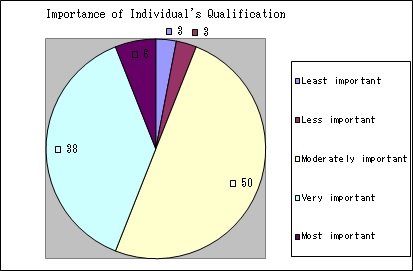
Table 2
|
Scale |
Least
Important |
Less
Important |
Moderately
Important |
Very
Important |
Most
Important |
|
Ratings |
1 |
2 |
3 |
4 |
5 |
|
Answers |
3 |
6 |
13 |
47 |
31 |
Graph 2
Question 3: How Important do you Think that those Networking abilities are Important in the Development of an Individual as a Personal Brand?
Table 3
|
Scale |
Least Important |
Less Important |
Moderately Important |
Very Important |
Most Important |
|
Rating |
1 |
2 |
3 |
4 |
5 |
|
Answers |
|
3 |
13 |
48 |
37 |
Graph 3
Question 4: What do you think is Important for a Celebrity to have? Rate the following Accordingly
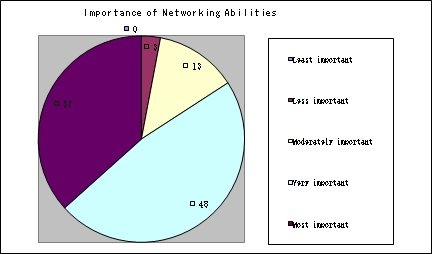
Table 4
The comprehensive rating question shows that the respondents give the most importance to Sociability and competence on the basis of the mean of these values. Hence, Sociability, Competence, Authenticity and Charm respectively, are important factors in building a Personal Brand.
|
Scale |
Least Important |
Less Important |
Moderately Important |
Very Important |
Most Important |
|
Rating |
1 |
2 |
3 |
4 |
5 |
|
a.
Competence |
|
|
25 |
38 |
37 |
|
b.
Sociability |
|
3 |
13 |
50 |
34 |
|
c.
Charm |
|
13 |
22 |
34 |
31 |
|
d.
Authenticity |
|
9 |
13 |
44 |
34 |
Graph 4
Question 5: Do you Think Dr. Shahid Masood’s Expertises are Relevant to the Topics Discussed in the Questions above?
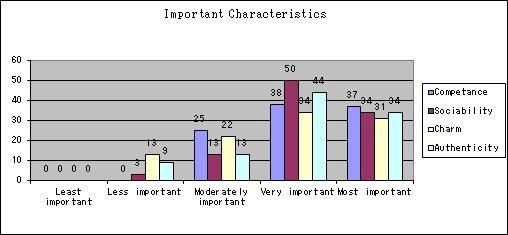
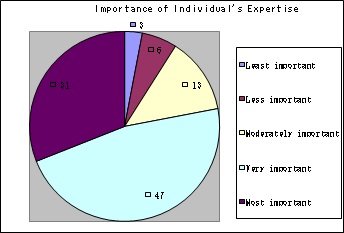
Table 5
|
Scale |
Do
not agree |
Agree
a little |
Moderately
Important |
Agree
a lot |
Completely
agree |
|
Rating |
1 |
2 |
3 |
4 |
5 |
|
Answers |
6 |
19 |
40 |
28 |
7 |
Graph 5
Question 6. Rate Dr. Shahid Masood on the following
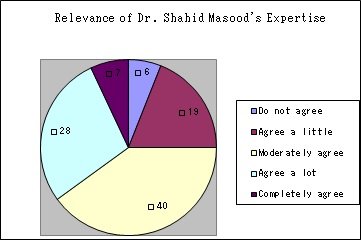
Table 6
This comprehensive question result verifies the results of Question 4, which are rated competence and Sociability as the most important factors.
|
|
Least Important |
Less Important |
Moderately Important |
Very Important |
Most Important |
|
|
1 |
2 |
3 |
4 |
5 |
|
a.
Competence |
6 |
10 |
21 |
51 |
12 |
|
b.
Sociability |
5 |
4 |
33 |
42 |
16 |
|
c.
Charm |
2 |
38 |
28 |
24 |
8 |
|
d.
Authenticity |
5 |
21 |
22 |
37 |
15 |
Graph 6
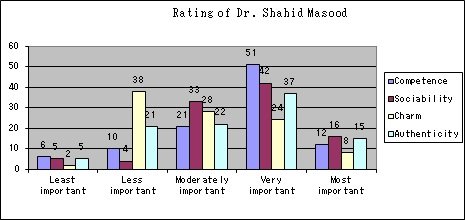
Data Analysis
Calculations of chi-square testing and Spearman's rank correlations were made in pursuance of testing the various hypotheses that had been formulated through a literature review as well as generalized observations. Analysis was done by comparison of Questions 1, 2 and 3 against Question 5 of the questionnaire and by comparison of Comprehensive Questions 4 and 6. The analysis will be discussed in correlation with the relevant Hypothesis as mentioned earlier.
The questionnaire was designed to assess the four variables selected during the hypothesis formulation process. The questions related to testing various variables are as under:
? Questions 1 and 2 asking the relation of an individual's qualification and expertise respectively to the attainment of celebrity status tested the Competence variable in Hypothesis 1.
? Question 3 asked about the importance of networking abilities in the development of a Personal Brand, hence catering to the Sociability variable in Hypothesis 2.
? Question 4 was a comprehensive question that asked respondents to rate the variables of Competence, Sociability, Charm and Authenticity.
? Question 5 asked about the relevance of Dr. Shahid Masood’s expertise to the topics discussed above
, keeping in view the difference between his education and profession as a medical doctor and his career as a journalist.
? Question 6 asked the respondents to rate Dr. Shahid Masood on the basis of the Four variables of the Hypothesis.
Comparison and Analysis of Questions
As stated above, each of the questions was related to the core Hypotheses selected for this research, and questions 1, 2, 3 and 4 were then tested against the results of questions 5 and 6 to test the validity of the hypotheses.
The comprehensive questions 4 and 6 were compared and analyzed separately in order to determine the factuality of the hypothesis. All the variables of the hypotheses, i.e. Competence, Sociability, Charm and Authenticity, were analyzed separately to ascertain their validity.
Hypothesis 1: Competence affects the Development of Personal Brand
In order to test this hypothesis, Question 1 and Question 2 were compared against Question 5, as explained earlier. (see Questionnaire; Appendix). Competence is the independent variable in this case to assess the effect on the development of the personal brand. Undertaking a cross tabulation analysis of each of the independent variable with the dependent one, the following results were obtained:
Table 6 shows the results of cross tabulation analysis of the relevance, Dr. Shahid Masood's expertise to the variable of individual's qualification which relates to the Competence variable in Hypothesis. The higher the response indicator of the respondents, the higher the relevance of this variable to Dr. Shahid Masood's case. Most of the respondents held that Qualification was only moderately important in this case as Dr. Shahid Masood is a doctor by profession and a journalist by career.
Table 7
Table 7 shows the results of cross tabulation analysis of the relevance Dr. Shahid Masood's expertise to the variable of individual's qualification which relates to the Competence variable in Hypothesis. The higher the response indicator of the respondents, the higher the relevance of this variable to Dr. Shahid's case. Most of the respondents held that Expertise is very important and many also rated it as the most important in this case.
|
Chi-Square Tests |
|||
|
|
Value |
df |
Asymp. Sig. (2-sided) |
|
Pearson Chi-Square |
56.678a |
16 |
.000 |
|
Likelihood Ratio |
46.386 |
16 |
.000 |
|
Linear-by-Linear
Association |
24.368 |
1 |
.000 |
|
N of Valid Cases |
100 |
|
|
|
a. 19 cells (76.0%) have an expected count of less than 5. The minimum
expected count is .18. |
|||
Table 8
Table 8 shows that the chi-square value for these two variables is 66.403 while the asymptotic significance (p-value) is .000, which shows that these two variables are associated; hence, an individual's expertise is a very important factor in the development of a Personal Brand.The above-mentioned analysis shows that competence is a very important factor in the development of a Personal Brand. However, this analysis is not yet complete and the analysis below also takes into account the comprehensive questions, which then would form the complete analysis for the evaluation of all four hypotheses. Comprehensive Questions ComparisionTable 13 shows the results of cross tabulation analysis of the relevance Dr. Shahid Masood's Competence to the variable of individual competence, which relates to the Competence variable in Hypothesis 1. The higher the response indicator of the respondents, the higher the relevance of this variable to Dr. Shahid's case. An almost equal number of respondents held that competence is a very important and most important factor in the development of the Personal Brand of both individuals as well as a case in point, i.e. Dr. Shahid Masood. This inference corresponds with earlier analysis of questions 1 and 2. Hence it can be said that Hypothesis 1 is valid.
|
Chi-Square Tests |
|||
|
|
Value |
df |
Asymp. Sig. (2-sided) |
|
Pearson Chi-Square |
66.403a |
16 |
.000 |
|
Likelihood Ratio |
58.059 |
16 |
.000 |
|
Linear-by-Linear Association |
31.762 |
1 |
.000 |
|
N of Valid Cases |
100 |
|
|
|
a.
18 cells (72.0%) have an expected count of less than 5. The minimum expected
count is .18. |
|||
Table 9
Table 16 shows that the chi-square value for these two variables is 27.586, while the asymptotic significance (p-value) is .000, which shows that these two variables are associated; hence, competence plays an important role in the development of a Personal brand.
Hypothesis 2: Sociability affects the Development of Personal BrandQuestion 3 and 5: Sociability and Personal BrandTable 13 shows the results of cross tabulation analysis of the relevance Dr. Shahid Masood's expertise to the variable of networking abilities which relates to the Sociability variable in Hypothesis. The higher the response indicator of the respondents, the higher the relevance of this variable to Dr. Shahid's case. Most of the respondents held that Networking is very important and many also rated it as the most important in this case.Table 14 shows that the chi-square value for these two variables is 45.392 while the asymptotic significance (p-value) is .000, which shows that these two variables are associated; hence, Networking ability is a very important factor in the development of a Personal Brand.The above-mentioned analysis shows that Sociability is also a very important factor in the development of Personal Brands.The majority of the respondents held that Sociability is a very important factor in the development of the personal brand of both individuals as well as a case in point i.e. Dr. Shahid Masood. This inference corresponds with an earlier analysis of question 3. Hence it can be said that Hypothesis 2 is valid. Table 18 shows that the chi-square value for these two variables is 34.375, while the asymptotic significance (p-value) is .001, which shows that these two variables are associated; hence, Sociability plays an important role in the development of Personal Brand.The majority of the respondents held that charm is a very important factor in the development of the personal brand of both individuals as well as a case in point i.e. Dr. Shahid Masood. However, many respondents also rated it a moderately and less important factor. Therefore, it can be inferred that the hypothesis is valid, but the variable of charm is relatively less important. Dr. Shahid Masood's Authenticity to the variable of individual Authenticity relates to the Authenticity variable in Hypothesis 4. The higher the response indicator of the respondents, the higher the relevance of this variable to Dr. Shahid's case. The respondents' answers show that Authenticity is very important and most important in the development of the personal brand of both individuals as well as a case in point, i.e. Dr. Shahid Masood. Therefore, it can be inferred that the hypothesis is valid and that Authenticity is a very important variable in the development of a Personal Brand.In the light of the above-mentioned analysis, it can be concluded that the four variables tested in this thesis play a vital role in the formation and development of Personal Brands. The relative importance of each of these attributes would depend on the profession and the target audience of the personality. In the case of Dr. Shahid Masood, Competence and Sociability can be regarded as the most important attributes in building his personal brand. If we take another example like Imran Khan, the relative importance of these attributes would change. Imran Khan's brand was built on his charisma as well as his competence as a cricketer. Authenticity is both cases is acquired through a sustained level of performance. His Personal Brand, however, could not bring him the same fame and success in the field of politics as it did in cricket. This example displays the importance of rebranding strategy in Personal Branding as well. An example of a successful rebranding of a Personal Brand is JunaidJumshaid. They rebranded himself from a pop icon to a religious person who restricts himself to singing naats and humds. He changed his visual brand elements as well and assumed an outlook of a typical religious man in order to alter his personal brand. As mentioned in the introductory chapter, Personal Branding has existed for a very long time, but it has always been mixed up with the concept of celebrity branding. The field of Personal Branding needs a lot of research, especially from the aspect of branding at the level of professions and non-celebrity individuals or individuals working in niche areas. The four variables that have been discussed in this research are as much applicable to professionals working in any field.
|
Chi-Square
Tests |
|||
|
|
Value |
df |
Asymp. Sig. (2-sided) |
|
Pearson
Chi-Square |
27.586a |
8 |
.001 |
|
Likelihood
Ratio |
29.226 |
8 |
.000 |
|
Linear-by-Linear
Association |
16.601 |
1 |
.000 |
|
N
of Valid Cases |
100 |
|
|
|
a.
9 cells (60.0%) have an expected count of less than 5. The minimum expected
count is 1.50. |
|||
References
- Aaker, J. L. (1997). “Dimensions of brand personalityâ€, Journal of Marketing Research, 34, 347-56.
- Aaker, J. L. (1999). “The malleable self: the role of self-expression in persuasionâ€, Journal of Marketing Research, 36, 45-57.
- Azoulay, A., & Kapferer, J. N. (2003). “Do brand personality scales really measure brand personality?â€, Journal of Brand Management, 11(2), 143-55.
- Beverland, M. (2006). “The ‘real thing’: branding authenticity in the luxury wine trade â€, Journal of Business Research, 59(2), 251-8.
- Chen, Z. G., & Chang, Y. X. (1989). Psychology of Personality, 1st ed., Wu-Nan Book Inc., Taipei.
- Erving, G. (1959). The Presentation of Self in Everyday Life, University of Edinburgh Social Sciences Research Centre. Anchor Books edition, 1959.
- atima, K., Ahmed, A., & Shafi, S. (2021), “Marxism in Zakia Mashhadi’s Death of an Insectâ€. Global Social Sciences Review, 6(3), 28-37.
- Goldberg, L. R. (1990). “An alternative ‘description of personality’: the big-five factor structureâ€, Journal of Personality and Social Psychology, 59(6), 1216-29.
- Goulding, C. (2000), “The commodification of the past, postmodern pastiche, and the search for authentic experiences at contemporary heritage attractionsâ€, European Journal of Marketing, 34(7), 835-53.
- Jacoby, J., & Olson, J. C. (1970). An Attitude Model of Brand Loyalty: Conceptual Underpinnings and Instrumentation Research, John Wiley & Sons, New York, NY.
- Kamakura, W. A., & Russell, G. J. (1991). Measuring Consumer Perceptions of Brand Quality with Scanner Data: Implications forBrand Equity, Report Number 91-122, Marketing Science Institute, Cambridge, MA.
Cite this article
-
APA : Zafar, M. R., Sultan, R. M. Y., & Shahzad, A. (2022). Personal Branding: A Study on the Effects of Sociability and Charisma on Perceived Competence and Authenticity. Global Social Sciences Review, VII(I), 230-243. https://doi.org/10.31703/gssr.2022(VII-I).23
-
CHICAGO : Zafar, Muhammad Rehan, Raja Muhammad Yasin Sultan, and Adeel Shahzad. 2022. "Personal Branding: A Study on the Effects of Sociability and Charisma on Perceived Competence and Authenticity." Global Social Sciences Review, VII (I): 230-243 doi: 10.31703/gssr.2022(VII-I).23
-
HARVARD : ZAFAR, M. R., SULTAN, R. M. Y. & SHAHZAD, A. 2022. Personal Branding: A Study on the Effects of Sociability and Charisma on Perceived Competence and Authenticity. Global Social Sciences Review, VII, 230-243.
-
MHRA : Zafar, Muhammad Rehan, Raja Muhammad Yasin Sultan, and Adeel Shahzad. 2022. "Personal Branding: A Study on the Effects of Sociability and Charisma on Perceived Competence and Authenticity." Global Social Sciences Review, VII: 230-243
-
MLA : Zafar, Muhammad Rehan, Raja Muhammad Yasin Sultan, and Adeel Shahzad. "Personal Branding: A Study on the Effects of Sociability and Charisma on Perceived Competence and Authenticity." Global Social Sciences Review, VII.I (2022): 230-243 Print.
-
OXFORD : Zafar, Muhammad Rehan, Sultan, Raja Muhammad Yasin, and Shahzad, Adeel (2022), "Personal Branding: A Study on the Effects of Sociability and Charisma on Perceived Competence and Authenticity", Global Social Sciences Review, VII (I), 230-243
-
TURABIAN : Zafar, Muhammad Rehan, Raja Muhammad Yasin Sultan, and Adeel Shahzad. "Personal Branding: A Study on the Effects of Sociability and Charisma on Perceived Competence and Authenticity." Global Social Sciences Review VII, no. I (2022): 230-243. https://doi.org/10.31703/gssr.2022(VII-I).23
